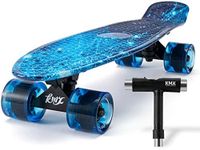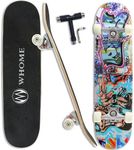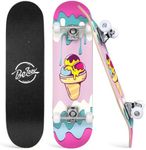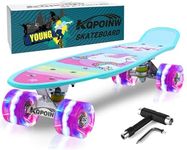Buying Guide for the Best Skateboards For Kids
Choosing a skateboard for kids is all about finding the right balance between safety, ease of use, and fun. Kids need a board that matches their size, skill level, and the type of skating they want to try. It's important to focus on features that make learning easier and safer, while also allowing room for growth as their skills improve. Understanding the key specifications will help you make a confident choice that keeps your child excited and protected while skating.Deck SizeThe deck size refers to the length and width of the skateboard's main board. This is important because a board that's too big or too small can be hard for a child to control. For younger or smaller kids, a narrower and shorter deck is easier to handle, while older or taller kids may need a wider and longer deck for stability. Generally, decks under 7 inches wide are best for kids under 8 years old, while those between 7 and 8 inches suit older children. To pick the right size, consider your child's age, shoe size, and height—smaller kids need smaller decks for better control and comfort.
Deck MaterialDeck material affects the skateboard's strength, weight, and flexibility. Most kids' skateboards are made from maple wood, which is durable and has a good balance of strength and flexibility. Some boards use plastic, which is lighter and often found in mini cruisers for very young kids. Maple is best for learning tricks and general use, while plastic can be good for very young beginners who need a lightweight board. Choose maple for durability and versatility, or plastic for very young kids who need something light and easy to carry.
Wheel Size and HardnessWheel size and hardness determine how the skateboard rolls and grips different surfaces. Smaller wheels (around 50-54mm) are easier for kids to control and are better for smooth surfaces like skate parks. Larger wheels (55mm and above) roll faster and handle rougher ground, but can be harder to control for beginners. Wheel hardness is measured in durometer; softer wheels (78A-87A) grip better and are smoother on rough surfaces, while harder wheels (88A-101A) are faster but less forgiving. For most kids, medium-sized, softer wheels are best for learning and general use, especially if they'll be skating on sidewalks or rougher ground.
TrucksTrucks are the metal parts that attach the wheels to the deck and allow the board to turn. The width of the trucks should match the width of the deck for stability and control. Lighter trucks are easier for kids to maneuver, while heavier trucks can be more durable. For beginners, standard trucks that match the deck width are usually the best choice, as they provide a good balance of stability and turning ability. Make sure the trucks are not too loose or too tight, as this affects how easily the board turns.
Grip TapeGrip tape is the rough surface on top of the deck that helps keep feet from slipping. Good grip tape is important for safety, especially for beginners who are still learning to balance. Most skateboards come with grip tape already applied, but the quality can vary. Look for boards with a consistent, sandpaper-like texture that covers the whole deck. This will help your child stay secure on the board, especially when learning new moves.
WeightThe weight of the skateboard affects how easy it is for a child to carry and control. Lighter boards are easier for young kids to pick up and maneuver, but very light boards may not be as durable. Heavier boards can be more stable but might be harder for small children to handle. For most kids, a board that feels comfortable to carry and lift is ideal. If your child struggles to pick up the board, it may be too heavy for them.

















